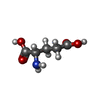+ データを開く
データを開く
- 基本情報
基本情報
| 登録情報 | データベース: PDB / ID: 8jd1 | |||||||||
|---|---|---|---|---|---|---|---|---|---|---|
| タイトル | Cryo-EM structure of mGlu2-mGlu3 heterodimer in Rco state | |||||||||
 要素 要素 |
| |||||||||
 キーワード キーワード | MEMBRANE PROTEIN / Complex structure / mGlu2-3 heterodimer | |||||||||
| 機能・相同性 |  機能・相同性情報 機能・相同性情報regulation of cellular component organization / regulation of response to drug / group II metabotropic glutamate receptor activity / regulation of cellular response to stress / macrolide binding / activin receptor binding / TORC1 complex / regulation of skeletal muscle contraction by regulation of release of sequestered calcium ion / cytoplasmic side of membrane / transforming growth factor beta receptor binding ...regulation of cellular component organization / regulation of response to drug / group II metabotropic glutamate receptor activity / regulation of cellular response to stress / macrolide binding / activin receptor binding / TORC1 complex / regulation of skeletal muscle contraction by regulation of release of sequestered calcium ion / cytoplasmic side of membrane / transforming growth factor beta receptor binding / intracellular glutamate homeostasis / TGFBR1 LBD Mutants in Cancer / behavioral response to nicotine / regulation of protein metabolic process / type I transforming growth factor beta receptor binding / negative regulation of adenylate cyclase activity / negative regulation of activin receptor signaling pathway / G protein-coupled glutamate receptor signaling pathway / heart trabecula formation / I-SMAD binding / Class C/3 (Metabotropic glutamate/pheromone receptors) / glutamate receptor activity / regulation of amyloid precursor protein catabolic process / terminal cisterna / ryanodine receptor complex / glutamate secretion / signaling receptor inhibitor activity / long-term synaptic depression / regulation of glutamate secretion / 'de novo' protein folding / astrocyte projection / ventricular cardiac muscle tissue morphogenesis / FK506 binding / cellular response to stress / regulation of dopamine secretion / TGF-beta receptor signaling activates SMADs / mTORC1-mediated signalling / regulation of ryanodine-sensitive calcium-release channel activity / Calcineurin activates NFAT / regulation of immune response / heart morphogenesis / postsynaptic modulation of chemical synaptic transmission / regulation of synaptic transmission, glutamatergic / supramolecular fiber organization / TGF-beta receptor signaling in EMT (epithelial to mesenchymal transition) / presynaptic modulation of chemical synaptic transmission / sarcoplasmic reticulum membrane / negative regulation of autophagy / T cell activation / sarcoplasmic reticulum / protein maturation / calcium channel regulator activity / peptidylprolyl isomerase / response to cocaine / peptidyl-prolyl cis-trans isomerase activity / negative regulation of transforming growth factor beta receptor signaling pathway / G protein-coupled receptor activity / SARS-CoV-1 activates/modulates innate immune responses / Z disc / protein folding / regulation of protein localization / presynaptic membrane / protein refolding / scaffold protein binding / G alpha (i) signalling events / chemical synaptic transmission / gene expression / dendritic spine / amyloid fibril formation / Potential therapeutics for SARS / transmembrane transporter binding / postsynaptic membrane / positive regulation of canonical NF-kappaB signal transduction / positive regulation of phosphatidylinositol 3-kinase/protein kinase B signal transduction / non-specific serine/threonine protein kinase / postsynaptic density / axon / protein serine/threonine kinase activity / dendrite / protein-containing complex binding / glutamatergic synapse / ATP binding / membrane / plasma membrane / cytosol / cytoplasm 類似検索 - 分子機能 | |||||||||
| 生物種 |  Homo sapiens (ヒト) Homo sapiens (ヒト) | |||||||||
| 手法 | 電子顕微鏡法 / 単粒子再構成法 / クライオ電子顕微鏡法 / 解像度: 3.7 Å | |||||||||
 データ登録者 データ登録者 | Wang, X. / Wang, M. / Xu, T. / Feng, Y. / Han, S. / Lin, S. / Zhao, Q. / Wu, B. | |||||||||
| 資金援助 |  中国, 2件 中国, 2件
| |||||||||
 引用 引用 |  ジャーナル: Cell Res / 年: 2023 ジャーナル: Cell Res / 年: 2023タイトル: Structural insights into dimerization and activation of the mGlu2-mGlu3 and mGlu2-mGlu4 heterodimers. 著者: Xinwei Wang / Mu Wang / Tuo Xu / Ye Feng / Qiang Shao / Shuo Han / Xiaojing Chu / Yechun Xu / Shuling Lin / Qiang Zhao / Beili Wu /  要旨: Heterodimerization of the metabotropic glutamate receptors (mGlus) has shown importance in the functional modulation of the receptors and offers potential drug targets for treating central nervous ...Heterodimerization of the metabotropic glutamate receptors (mGlus) has shown importance in the functional modulation of the receptors and offers potential drug targets for treating central nervous system diseases. However, due to a lack of molecular details of the mGlu heterodimers, understanding of the mechanisms underlying mGlu heterodimerization and activation is limited. Here we report twelve cryo-electron microscopy (cryo-EM) structures of the mGlu2-mGlu3 and mGlu2-mGlu4 heterodimers in different conformational states, including inactive, intermediate inactive, intermediate active and fully active conformations. These structures provide a full picture of conformational rearrangement of mGlu2-mGlu3 upon activation. The Venus flytrap domains undergo a sequential conformational change, while the transmembrane domains exhibit a substantial rearrangement from an inactive, symmetric dimer with diverse dimerization patterns to an active, asymmetric dimer in a conserved dimerization mode. Combined with functional data, these structures reveal that stability of the inactive conformations of the subunits and the subunit-G protein interaction pattern are determinants of asymmetric signal transduction of the heterodimers. Furthermore, a novel binding site for two mGlu4 positive allosteric modulators was observed in the asymmetric dimer interfaces of the mGlu2-mGlu4 heterodimer and mGlu4 homodimer, and may serve as a drug recognition site. These findings greatly extend our knowledge about signal transduction of the mGlus. | |||||||||
| 履歴 |
|
- 構造の表示
構造の表示
| 構造ビューア | 分子:  Molmil Molmil Jmol/JSmol Jmol/JSmol |
|---|
- ダウンロードとリンク
ダウンロードとリンク
- ダウンロード
ダウンロード
| PDBx/mmCIF形式 |  8jd1.cif.gz 8jd1.cif.gz | 280.1 KB | 表示 |  PDBx/mmCIF形式 PDBx/mmCIF形式 |
|---|---|---|---|---|
| PDB形式 |  pdb8jd1.ent.gz pdb8jd1.ent.gz | 204.4 KB | 表示 |  PDB形式 PDB形式 |
| PDBx/mmJSON形式 |  8jd1.json.gz 8jd1.json.gz | ツリー表示 |  PDBx/mmJSON形式 PDBx/mmJSON形式 | |
| その他 |  その他のダウンロード その他のダウンロード |
-検証レポート
| 文書・要旨 |  8jd1_validation.pdf.gz 8jd1_validation.pdf.gz | 652.1 KB | 表示 |  wwPDB検証レポート wwPDB検証レポート |
|---|---|---|---|---|
| 文書・詳細版 |  8jd1_full_validation.pdf.gz 8jd1_full_validation.pdf.gz | 697.1 KB | 表示 | |
| XML形式データ |  8jd1_validation.xml.gz 8jd1_validation.xml.gz | 29 KB | 表示 | |
| CIF形式データ |  8jd1_validation.cif.gz 8jd1_validation.cif.gz | 44.2 KB | 表示 | |
| アーカイブディレクトリ |  https://data.pdbj.org/pub/pdb/validation_reports/jd/8jd1 https://data.pdbj.org/pub/pdb/validation_reports/jd/8jd1 ftp://data.pdbj.org/pub/pdb/validation_reports/jd/8jd1 ftp://data.pdbj.org/pub/pdb/validation_reports/jd/8jd1 | HTTPS FTP |
-関連構造データ
| 関連構造データ |  36172MC  8jcuC  8jcvC  8jcwC  8jcxC  8jcyC  8jczC  8jd0C  8jd2C 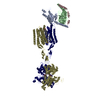 8jd3C  8jd4C 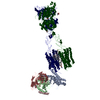 8jd5C 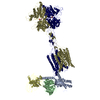 8jd6C M: このデータのモデリングに利用したマップデータ C: 同じ文献を引用 ( |
|---|---|
| 類似構造データ | 類似検索 - 機能・相同性  F&H 検索 F&H 検索 |
- リンク
リンク
- 集合体
集合体
| 登録構造単位 | 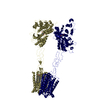
|
|---|---|
| 1 |
|
- 要素
要素
| #1: タンパク質 | 分子量: 109398.914 Da / 分子数: 1 / 由来タイプ: 組換発現 / 由来: (組換発現)  Homo sapiens (ヒト) / 遺伝子: GRM2, GPRC1B, MGLUR2, FKBP1A, FKBP1, FKBP12 / 発現宿主: Homo sapiens (ヒト) / 遺伝子: GRM2, GPRC1B, MGLUR2, FKBP1A, FKBP1, FKBP12 / 発現宿主:  参照: UniProt: Q14416, UniProt: P62942, peptidylprolyl isomerase | ||||||
|---|---|---|---|---|---|---|---|
| #2: タンパク質 | 分子量: 112712.961 Da / 分子数: 1 / 由来タイプ: 組換発現 / 由来: (組換発現)  Homo sapiens (ヒト) / 遺伝子: GRM3, GPRC1C, MGLUR3, MTOR / 発現宿主: Homo sapiens (ヒト) / 遺伝子: GRM3, GPRC1C, MGLUR3, MTOR / 発現宿主:  参照: UniProt: Q14832, UniProt: A0A8V8TRG9, non-specific serine/threonine protein kinase | ||||||
| #3: 化合物 | | #4: 化合物 | ChemComp-CLR / 研究の焦点であるリガンドがあるか | Y | Has protein modification | Y | |
-実験情報
-実験
| 実験 | 手法: 電子顕微鏡法 |
|---|---|
| EM実験 | 試料の集合状態: PARTICLE / 3次元再構成法: 単粒子再構成法 |
- 試料調製
試料調製
| 構成要素 | 名称: mGlu2-mGlu3 heterodimer in presence of glutamate, JNJ-40411813, and CaCl2 タイプ: COMPLEX / Entity ID: #1-#2 / 由来: MULTIPLE SOURCES |
|---|---|
| 由来(天然) | 生物種:  Homo sapiens (ヒト) Homo sapiens (ヒト) |
| 由来(組換発現) | 生物種:  |
| 緩衝液 | pH: 7.5 |
| 試料 | 包埋: NO / シャドウイング: NO / 染色: NO / 凍結: YES |
| 急速凍結 | 凍結剤: ETHANE |
- 電子顕微鏡撮影
電子顕微鏡撮影
| 実験機器 |  モデル: Titan Krios / 画像提供: FEI Company |
|---|---|
| 顕微鏡 | モデル: FEI TITAN KRIOS |
| 電子銃 | 電子線源:  FIELD EMISSION GUN / 加速電圧: 300 kV / 照射モード: SPOT SCAN FIELD EMISSION GUN / 加速電圧: 300 kV / 照射モード: SPOT SCAN |
| 電子レンズ | モード: BRIGHT FIELD / 最大 デフォーカス(公称値): 1500 nm / 最小 デフォーカス(公称値): 800 nm |
| 撮影 | 電子線照射量: 70 e/Å2 フィルム・検出器のモデル: GATAN K3 BIOQUANTUM (6k x 4k) |
- 解析
解析
| CTF補正 | タイプ: NONE | ||||||||||||||||||||||||
|---|---|---|---|---|---|---|---|---|---|---|---|---|---|---|---|---|---|---|---|---|---|---|---|---|---|
| 3次元再構成 | 解像度: 3.7 Å / 解像度の算出法: FSC 0.143 CUT-OFF / 粒子像の数: 252188 / 対称性のタイプ: POINT | ||||||||||||||||||||||||
| 精密化 | 立体化学のターゲット値: GeoStd + Monomer Library + CDL v1.2 | ||||||||||||||||||||||||
| 原子変位パラメータ | Biso mean: 51.45 Å2 | ||||||||||||||||||||||||
| 拘束条件 |
|
 ムービー
ムービー コントローラー
コントローラー





















 PDBj
PDBj
















